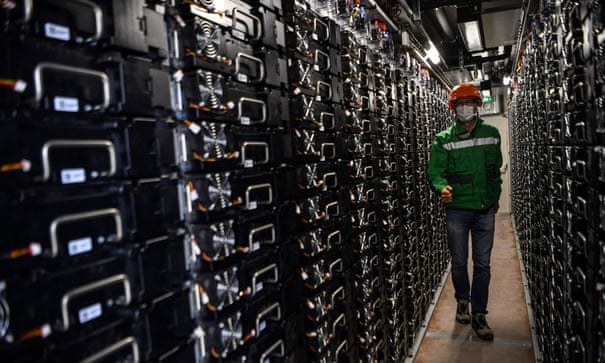Green – or envious? The winners and losers in Britain’s climate change plan.

The tougher target for carbon reduction could dramatically reshape the fortunes of several industries – for better or worse
Boris Johnson’s plan to accelerate the UK’s climate ambitions over the next 15 years, revealed last week, will hasten progress towards a carbon-neutral economy by 2050. The new target – to cut the UK’s carbon emissions by 78%, compared with 1990 levels, by 2035 – toughens an earlier pledge for a 68% reduction by 2030. This greater ambition could boost the fortunes of several low-carbon technologies which stand ready for a rapid roll-out. Here are the winners and losers from the new targets.
Winners
Battery storage Energy-storage developers are among those in line to benefit from Britain’s “green rush”. The electricity system has shouldered much of the UK’s carbon-cutting responsibilities in recent years, thanks to a boom in renewable energy and the steady shutdown of polluting coal power plants. But the UK will need to plug into an increasingly electric future to power electric vehicles and low-carbon home heating systems, which will mean making every megawatt of renewable electricity count.
More wind turbines and solar farms are expected to mushroom along the coast and hillsides of the UK, but the country will need more batteries to store their clean energy for still, grey days. Today there is 1.2GW of installed battery storage operating in the UK, but a pipeline of projects totalling 14.5GW could soon begin harnessing the power from nearby windfarms and solar arrays in the years ahead.
Green home experts Household hobs and gas boilers make up about 15% of the UK’s carbon emissions. In 2019 the government’s official climate advisers, the Committee on Climate Change, warned that the UK’s homes were “shockingly unprepared” for the challenge of a net zero carbon target. Since then, the government has scrapped the £1.5bn green homes grant, which promised sums of up to £5,000 (or in certain cases £10,000) to put in insulation or low-carbon heating. Simply put, a tougher climate target for 2035 will leave a lot of catching up to do for policymakers, and could mean a potential deluge of work for the army of small businesses fitting heat pumps, electric hobs and double-glazed windows.
Home solar panels with small battery packs linked to car chargers and smart home appliances are also likely to boom. A report by the Green Alliance thinktank estimates that all the UK’s 29 million homes will need at least some work to make the grade in a carbon-neutral future – but this would create 190,000 jobs, save £7.5bn a year on energy bills and ease pressure on the NHS by preventing illness.

Recycling plants The carbon emissions from the UK’s waste makes up 6% of the country’s total carbon footprint. This includes the household rubbish which makes its way to landfills and incinerators, as well as waste water treatment and composting. This often-overlooked contributor to emissions has failed to show much improvement since 2013. But under the government’s more ambitious path to net zero there can be no room for laggards. A new tax has already been put forward to target plastic packaging that does not contain at least 30% recycled plastic, and the government has also set a target for 65% of household waste to be recycled by 2035, and for a maximum of 10% municipal waste to end up in landfill.
Recycling company DS Smith has warned that the UK is likely to miss this 2035 target by at least 13 years without sweeping changes to the UK’s waste collection and recycling facilities. With the government’s growing incentive to reduce emissions, the industry is in line for a shake-up.
Carbon capture Technology that can capture carbon dioxide from factories and power plants, before it reaches the atmosphere, is expected to play a major role in the UK’s climate action plans. The prime minister has pledged £1bn of public funds to help develop four major carbon capture schemes in Britain by 2030 as part of his plan for a “green industrial revolution”.
Critics of the plan believe the uncertainty and cost means the UK would be better off finding low-carbon alternatives. The government itself has scrapped previous carbon-capture schemes due to similar concerns. But a tighter deadline to cut emissions is likely to pile further pressure on carbon-capture projects, which can trap, transport and permanently store emissions, particularly from heavy industry. Scientists at Edinburgh University have warned that carbon capture may be the only effective way the UK has in the short term to prevent the steel industry and cement manufacturing from continuing to pour emissions into the atmosphere.
But the plan will also ask more pressing questions for industries which risk being left behind.
Losers
The North Sea Last month the government struck a “landmark deal” with the North Sea oil industry to help the sector cut its carbon emissions while continuing to explore for new opportunities to produce oil and gas. The catch? Oil companies will need to pass a “climate compatibility” test which proves that each application to extract more fossil fuels from the North Sea is “compatible with the UK’s climate change objectives”.
Britain’s fresh climate ambitions will make this a tougher hurdle to clear, as domestic demand for fossil fuels could fall faster than first expected. The 2035 target is likely to quicken the pace towards low-carbon home heating, and make it tougher for the UK to run gas power plants unless they are fitted with carbon capture technology. Fewer gas power plants, home boilers and gas hobs could lead to a significant dent in the UK’s demand and make it more difficult to justify further North Sea drilling.
Crude refineries Britain’s oil refineries are also likely to see lower demand for their fossil-fuel products. The government’s transport decarbonisation plan, due later this year, is expected to set out a pathway for lower emissions from road, rail and aviation and provide funding to bolster public transport, walking and cycling. There may also be schemes to boost the take-up of electric vehicles, and a rise in fuel duty. Together, this could spell difficult times ahead for the UK’s refineries, which are already struggling after the sudden slowdown in demand for transport fuels during the pandemic. The Stanlow refinery in Ellesmere Port, one of the UK’s biggest, produces 16% of the UK’s diesel and petrol as well as almost 10 billion litres of aviation fuel a year. It is under pressure to refinance after a dire year for sales.
Airlines The UK’s plan to slash emissions also marks the first time that international aviation emissions, which make up 7% of the UK’s total carbon footprint, will be included in a climate target. This is likely to mean fewer flights, and particularly fewer long-haul journeys. The Committee on Climate Change has suggested raising the costs of flying with a frequent-flyer tax, or higher air passenger duty. The shift towards less frequent flying is likely to be made easier following the pandemic, when many companies stopped travelling to face-to-face meetings and went for videoconferencing, with positive results for costs and productivity.
Nuclear power plants The UK is currently building its first new nuclear power plant in a generation at the Hinkley Point C site in Somerset, and the government is in talks with its owner, EDF Energy, to build another nuclear plant at Sizewell in Suffolk. Big reactors are highly controversial due to sky-high costs, long construction times and a risk of overspending by billions of pounds. A greater emphasis on cutting carbon by 2035 could add another argument against further large nuclear power plants in favour of options that can be built faster and cut emissions sooner. This bodes well for Rolls-Royce, which is hoping to develop a string of small modular reactors. It could begin manufacturing hundreds of small units to power the electricity system by 2030, with a far smaller risk of delays, at a time when fast climate action is crucial.
24 April 2021





